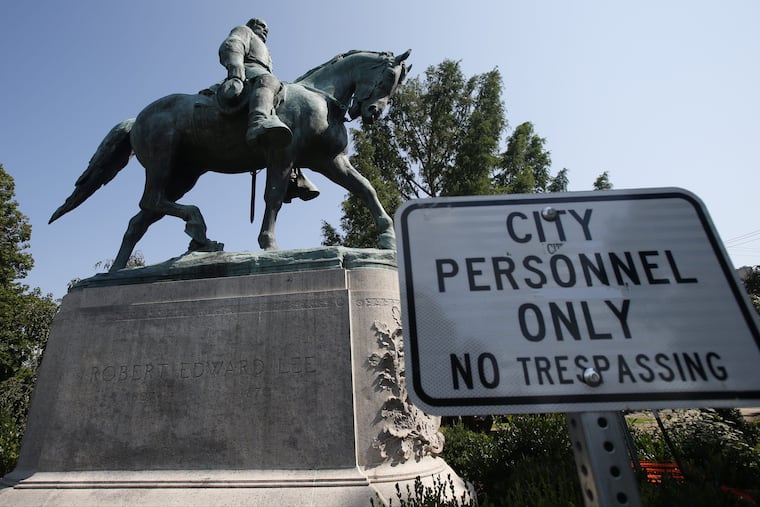A year after Charlottesville, Confederate nostalgia continues to undermine democracy | Opinion
Hate groups use Confederate symbolism to subvert democratic processes.

This weekend marks the one-year anniversary of the Unite the Right rally in Charlottesville, Va. The white nationalist event, organized to protest the removal of a Robert E. Lee statue from public grounds, degenerated into violence and even homicide. Its aftermath provided the opportunity for a national reckoning over persistent uses of Confederate symbolism to manipulate history and subvert democracy.
Unfortunately, national leaders and much of the mainstream media failed to facilitate this type of reckoning.
Over the last year, two questions have dominated public remembrance of the rally: Who was at fault for the violence — white supremacists or leftist counterprotesters? And was President Trump right to speak about "very fine people on both sides"?
Overwhelming attention to these questions — which inspired debates among politicians and pundits over abstract questions of blame and competing definitions of honor — represented a lost opportunity.
But Americans can still choose to remember the Unite the Right rally in even more illuminating ways. They can examine how uses of Confederate iconography distort history and subvert democracy — whether in Charlottesville or, say, in Pennsylvania communities (the Pennsylvania Light Foot Militia participated in the rally, and the commonwealth is home to dozens of hate groups). As a former resident of Charlottesville and current resident of Pennsylvania, I can attest that two aspects of the violence deserve far more attention than they have received.
Confederate mythology is designed to make racism seem honorable.
First, Confederate iconography — like the Lee statue in Charlottesville — has always symbolized an invented mythology, not accurate history. National discussion about the riots focused on what politicians said, or failed to say, in response. Questions about why so many Americans still embrace such a historically illegitimate mythology received comparatively little attention.
Confederate mythology — including tales of dignified Confederate generals, benevolent plantations, and noble Christian armies — distorts history into propaganda. Hate groups invoke this mythology to justify a political ideology based on racial subjugation and indiscriminate violence.
Confederate mythology is undeniably part of U.S. history, with continuing national implications for our political processes. But it should not dictate the terms of debate about U.S. history and political processes, whether locally or nationally.
Lee himself is a fitting example. He has been remembered as a kindly gentleman soldier, a personification of Confederate nobility. White House chief of staff John Kelly called Lee "an honorable man" in a post-Charlottesville interview. "Lee's elevation," Adam Serwer wrote in the Atlantic, "is a key part of a 150-year-old propaganda campaign designed to erase slavery as the cause of the war and whitewash the Confederate cause as a noble one." In fact, Lee was not an especially benevolent slave owner, and he waged war to defend a government based on principles of fundamental racial inequality.
Confederate mythology is designed to make systemic racism and violence seem not only honorable but consistent with American nationalism. Accepting neo-Confederate claims about history at face value, or focusing on politicians and pundits who see potential honor in those claims, hinders constructive dialogue about the deeply ahistorical meaning and purpose of Confederate symbolism.
Confederate symbolism is used as a destabilizer of democracy.
Second, hate groups use Confederate symbolism to subvert democratic processes. Post-Charlottesville debates about abstract questions of blame and honor undermined the opportunity to nationally confront the antidemocratic nature of Confederate nostalgia.
The Charlottesville City Council democratically voted to remove the city's Lee statue early in 2017. The Unite the Right rally constituted armed resistance to local democratic processes by outside groups. Hate groups organized the rally and paraded Confederate symbols to disrupt democracy and hijack civic space — not to constructively participate within. Indeed, Confederate movements routinely flourish in U.S. history following periods of democratic advocacy for civil rights.
Charlottesville's recent past illustrates the antidemocratic influences of Confederate nostalgia. In 1965, the city demolished a large African-American neighborhood known as Vinegar Hill and displaced hundreds of residents in the name of "urban renewal." These events unfolded amid resurgent Confederate "pride" in response to federal desegregation policies. Past and present, Confederate symbolism has carried inherently antidemocratic meaning in Charlottesville and throughout the nation.
Media fixation on politicians' statements and punditry following the Unite the Right rally overshadowed more difficult and substantive discussions about its meaning.
But there's still time, only a year later, for Americans to commemorate the violence in Charlottesville in even more constructive ways: by recognizing how Confederate nostalgia intentionally impedes a full understanding of the past while undermining democracy in the present.
Bradford Vivian is a professor of communication arts and sciences and director of the Center for Democratic Deliberation at Pennsylvania State University.